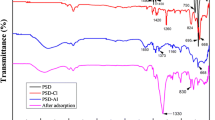Abstract
A novel phenol formaldehyde crown ether adsorbent PS@DB18C6 for the separation of Zn isotopes was synthesized by grafting of dibenzo-18-crown-6 (DB18C6) onto polystyrene (PS) particles with phenol formaldehyde. In batch adsorption experiments, the highest isotope discriminations (Δ66Zn = 38.8, Δ68Zn = 75.0) was obtained in 200 ppm Zn(II) acetone solution at 10 °C. Through chromatographic experiments, the separation coefficients of 5 m migration distance are 6.85 × 10–4 and 1.507 × 10–3. for the isotopic pairs of 66Zn/64Zn, 68Zn/64Zn respectively at 25 °C and the flow rate of feed solution was 8.04 ml/h. Therefore, the developed PS@DB18C6 composite would be a promising adsorbent for preparation of 64Zn depleted zinc by chromatographic separation.

















Similar content being viewed by others
References
Borisevich VD, Pavlov AV, Okhotina IA (2009) Depleted zinc: properties, application, production. Appl Radiat Isot 67:1167–1172
Ziemniak SE, Hanson M (2006) Zinc treatment effects on corrosion behavior of 304 stainless steel in high temperature, hydrogenated water. Corros Sci 48:2525–2546
Chmielewski AG (2012) Selected chemical aspects of nuclear power development. World J Nucl Sci Technol 02:154–160
Kamaya M (2020) Failure assessment curve for austenitic stainless steel pipes of nuclear power plants. Eng Fract Mech 238:107283
Arjmand F, Zhang L, Zhang Y, Guan K (2021) Effect of zinc injection on the electrochemical behavior and crack growth rate of a 316 L stainless steel in simulated primary coolant of pressurized water reactors. Mater Charact 177:111177
Tracy JG, Aaron WS (1993) Stable isotope enrichment—current and future potential. Nucl Instrum Methods Phys Res Sect A 334:45–50
Urey HC (1941) Separation and use of stable isotopes. J Appl Phys 12:270–277
Tcheltsov AN et al (2006) Centrifugal enrichment of zinc isotopes, their application in medicine and in increasing radiation safety in nuclear power plants. Nucl Instrum Methods Phys Res Sect A 561:52–57
Ban Y, Nomura M, Fujii Y (2002) Chromatographic separation of lithium isotopes with silica based monobenzo-15-crown-5 resin. Nucl Sci Technol 39:279–281
Bokhan PA, Zakrevskii DE, Fateev NV (2002) Selective photochemical isotope “burning” upon the interaction of resonant laser radiation with atoms. Jetp Lett 75:170–173
Pedersen CJ (1967) Cyclic polyethers and their complexes with metal salts. J Am Chem Soc 89:7017–8000
Nishizawa K, Nakamura K, Yamamoto T, Masuda T (1993) Zinc isotope effects in complex formation with a crown ether. Solvent Extr Ion Exch 11:389–394
Kim DW, Jeon YS, Eom TY, Suh MY, Lee CH (1991) Lithium isotope separation on a monobenzo-15-crown-5 resin. J Radioanalyt Nucl Chem 150:417–426
Ding X et al (2007) Zinc isotope separation in acetone by displacement chromatography using benzo-15-crown-5 resin. J Radioanalyt Nucl Chem 273:79–84
Ding X et al (2006) Chromatographic zinc isotope separation by phenol formaldehyde benzo crown resin. J Chromatogr A 1113:182–185
Singha Deb AK, Ali SM, Shenoy KT, Ghosh SK (2014) Nano cavity induced isotope separation of zinc: density functional theoretical modeling. J Chem Eng Data 59:2472–2484
Singha Deb AK et al (2020) DFT and MD simulation supplemented experiments for isotopic fractionation of zinc compounds using a macrocyclic crown ether appended polymeric resin. Phys Chem Chem Phys 22:14682–14693
Ding X, Nomura M, Fujii Y (2010) Zinc isotope effects by chromatographic chelating exchange resin. Prog Nucl Energy 52:164–167
Ding X et al (2006) Zinc isotope separation by phenol formaldehyde type 15-crown-5 resin in organic solvents. J Nucl Sci Technol 43:411–414
Pan X-H, Fu L-X, Wang H, Xue Y, Zu J-H (2021) Synthesis of novel sulfydry-functionalized chelating adsorbent and its application for selective adsorption of Ag(I) under high acid. Sep Purif Technol 271:118778
Ling P et al (2010) Adsorption of divalent heavy metal ions onto IDA-chelating resins: simulation of physicochemical structures and elucidation of interaction mechanisms. Talanta 81:424–432
Shahbazi A, Younesi H, Badiei A (2011) Functionalized SBA-15 mesoporous silica by melamine-based dendrimer amines for adsorptive characteristics of Pb(II), Cu(II) and Cd(II) heavy metal ions in batch and fixed bed column. Chem Eng J 168:505–518
Brito GGD et al (2014) Carbon isotope fractionation for cotton genotype selection. Pesq Agropec Bras 49:673–682
Tan Y, Kan D, Ding X, Nomura M, Fujii Y (2008) Zinc isotope effects in benzo crown resin by displacement chromatography. J Nucl Sci Technol 45:1078–1083
Zollinger DPh, Bulten E, Christenhusz A, Bos M, Van Der Linden WE (1987) Computerized conductometric determination of stability constants of complexes of crown ethers with alkali metal salts and with neutral molecules in polar solvents. Anal Chim Acta 198:207–222
Acknowledgements
This work was supported by the National Natural Science Foundation of China [12275177, 11975152].
Author information
Authors and Affiliations
Contributions
YX: methodology, data curation, writing—original draft. JZ: writing—review and editing, supervision, project administration, funding acquisition. XS: investigation. FL: investigation. JZ: investigation. YH: investigation. JC: test.
Corresponding author
Ethics declarations
Conflict of interest
The authors declare that they have no known competing financial interests or personal relationships that could have appeared to influence the work reported in this paper.
Additional information
Publisher's Note
Springer Nature remains neutral with regard to jurisdictional claims in published maps and institutional affiliations.
Rights and permissions
Springer Nature or its licensor (e.g. a society or other partner) holds exclusive rights to this article under a publishing agreement with the author(s) or other rightsholder(s); author self-archiving of the accepted manuscript version of this article is solely governed by the terms of such publishing agreement and applicable law.
About this article
Cite this article
Xue, Y., Zu, J., Su, X. et al. A synthesis of novel phenol formaldehyde type dibenzo-18-crown-6 resin for Zn(II) and zinc isotope separation. J Radioanal Nucl Chem 333, 519–530 (2024). https://doi.org/10.1007/s10967-023-09271-y
Received:
Accepted:
Published:
Issue Date:
DOI: https://doi.org/10.1007/s10967-023-09271-y




